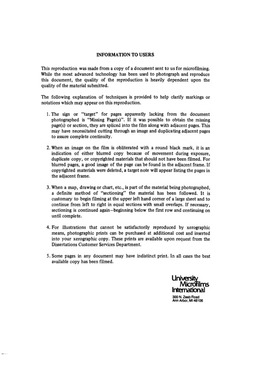| dc.contributor.author | Fincher, Betty, | en_US |
| dc.date.accessioned | 2013-08-16T12:28:58Z | |
| dc.date.available | 2013-08-16T12:28:58Z | |
| dc.date.issued | 1983 | en_US |
| dc.identifier.uri | https://hdl.handle.net/11244/5173 | |
| dc.description.abstract | In addition, subjects in the experimental groups were asked to play the melody one line at a time while watching an illuminated keyboard visualizer, which displayed lighted piano keys as they were played. The students heard the melody and saw its aural shape by watching the lighted keys. The students repeated each line after the researcher had played it. After the piece was played by rote twice line by line, the same procedure was repeated using two lines, rather than one line. Next the studnts were told to open their books and follow the music in their texts rather than watching the lighted visualizer for two more playings. After the prestudy, each student practiced individually, using earphones, at an electronic piano. The study took place in a Wurlitzer electronic piano laboratory. . . . (Author's abstract exceeds stipulated maximum length. Discontinued here with permission of author.) UMI | en_US |
| dc.description.abstract | The purpose of the study was to evaluate the impact of rote playing as a part of the prestudy procedure upon sight-reading skill development of beginning adult class piano students. Through rote teaching/learning, the students plays by imitating what he/she sees and hears. | en_US |
| dc.description.abstract | The experimental and control groups followed a carefully structured analytical prestudy procedure. Students were asked to volunteer to respond orally to specific questions pertaining to the piece under study. These questions and students' responses to them comprised the analytical prestudy procedure which was followed for each new exercise that was studied and played. | en_US |
| dc.description.abstract | In order to determine the effects of hearing and then playing a melody by rote prior to seeing the printed music, a research experiment was conducted. Four groups of students were selected for the experiment, two of which were exposed to the experimental treatment (rote playing) as a part of the regular instructional program while the other two groups (control) were denied the opportunity to play by rote. The design for this study was a pretest-posttest control group design, with two additional tests of readiness being administered to examine group equivalence. This procedure was adopted because subjects could not be randomly assigned to various research groups. All students with measurable sight-reading skills were transferred to a class which was not involved in the study. | en_US |
| dc.format.extent | vi, 114 leaves : | en_US |
| dc.subject | Education, Music. | en_US |
| dc.title | The effects of playing the melody by rote during the prestudy procedure upon sight reading skill development of beginning class piano students / | en_US |
| dc.title.alternative | The effects of playing the melody by rote ... | en_US |
| dc.type | Thesis | en_US |
| dc.thesis.degree | Ph.D. | en_US |
| dc.thesis.degreeDiscipline | School of Music | en_US |
| dc.note | Source: Dissertation Abstracts International, Volume: 44-12, Section: A, page: 3623. | en_US |
| ou.identifier | (UMI)AAI8403971 | en_US |
| ou.group | Weitzenhoffer Family College of Fine Arts::School of Music | |
